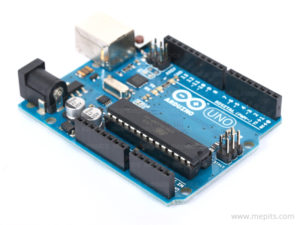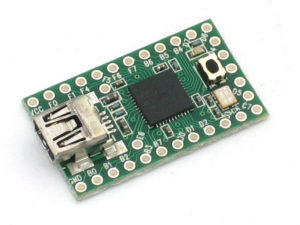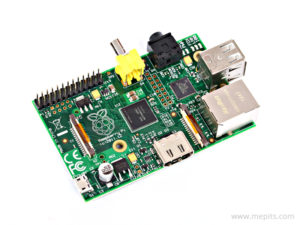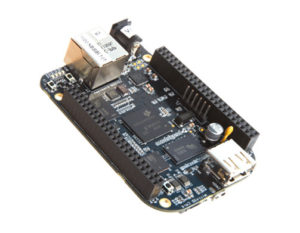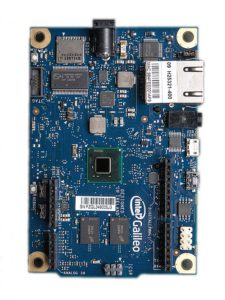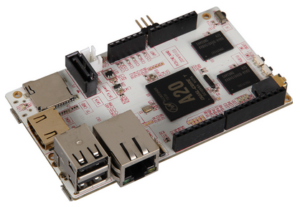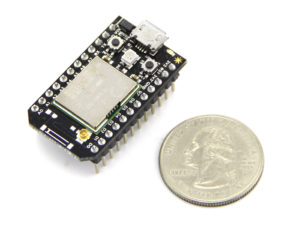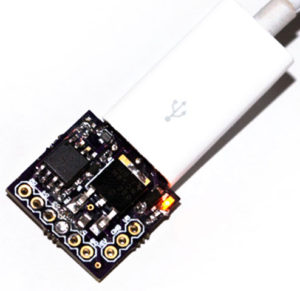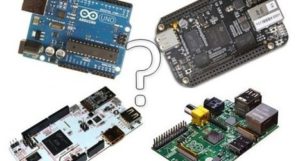 For a DIY projects, we have to choose between the Arduino, the Raspberry Pi, the BeagleBone, micvrocontroller, or others. We constantly ask if we make the best choice for a project and often our choice are more influence by our own skills for a boards rather the the needs. A little demystify of the most popular boards could easier a bit the selection process.
For a DIY projects, we have to choose between the Arduino, the Raspberry Pi, the BeagleBone, micvrocontroller, or others. We constantly ask if we make the best choice for a project and often our choice are more influence by our own skills for a boards rather the the needs. A little demystify of the most popular boards could easier a bit the selection process.
Below you can see a non-exhaustive list of mains electronic development boards available. I cannot explain all boards on the market, but many are inspired by these ones listed here.
| Electronic Boards | Description |
| Arduino Uno | Popular open-source electronics prototyping board focused around simple to-utilize equipment and software.
The Arduino Development Board is a good example of top development boards for DIY projects intended for all: specialists, designers, beginners and anybody intrigued by making. USB is always present with an aim of easily and quickly loading and transferring programs and communicate over virtual serial communication. Affordable and easy way to solve problems for Hobbyists, professionals, students and different companies and offices. |
| Teensy | Arduino inspired and compatible with IDE, Teensy is an USB-based microcontroller development system, in a very small footprint for better integration, capable of implementing many types of projects. All programming is done via the USB port.
The Last Teensy V3.0 have a more powerful ARM-microcontroller heart. |
| Raspberry Pi | The raspberry pi is a is small sized development board (like a size of a credit card). The raspberry pi can be easily plugged in to monitor, computer or your TV. Also it uses standard mouse and keyboard and can run Linux OS like normal computer. With its low price and power, it is perfect for students or hobbyists requiring powerful “brain” for their projects. |
| BeagleBone Black | It has some attractive new characteristics including moving the working system off the SD Card to an on-board flash memory. The board is sold for $45, intensely estimated against the Raspberry Pi which retails at $35 and it is less adaptable when you’re pondering joining it to outside hardware. Today BeagleBone Black Development Board is the best development boards for all hardware specialists and DIY projects venture mates for their performances and connectivity. |
| Intel Galileo Development Board | Intel Galileo, based on Quark processors which is made specifically for small size and low power electronics, is designed for some devices that are interactive, very simple and very complex projects. A good example is the humanoid robots.
One of the main merits of using Quark processors is that it consumes very little power and the prices are quite affordable (began at $70 US Dollars). And it is a powerful processor too. |
| pcDuino Development Board | The pcDuino is a mini PC or single board computer platform that runs PC like OS such as Ubuntu and Android ICS. Moreover, it has hardware headers interface compatible with Arduino lets you possibility to use Shields. You can compose code specifically on this board as though was an Arduino Development Board and run it locally on the board. SparkFun present assembling a connector to make the board structure figure and additionally stick perfect. At $60 it’s an appealing choice, and looks sufficiently simple to set up. |
| Photon Development Board | The Photon Development Board is a little Arduino-like, Wifi empowered, cloud-based software. Its programmable by means of Wifi like the YUN, but at the same time is supported by a cloud administration making your activities open, and updatable from anyplace, not simply on your neighborhood system. This is an interesting platform for only $19. |
| DigiSpark Development Board | An alternate tiny Arduino-good Attiny85 based board despite the fact you get only 6 I/O pins but this one is just $12. Moreover there are many shield units permitting you to effortlessly amplify its capacities. |
It is possible to develop his own microcontroller-based board for a special project. But often it is more important to firstly make a proof of concept and concentrating on the final goal rather than reinventing the wheel.
Comparison of main characteristic
Table below is for quick comparison of the boards.
| Boards | Processor | Connectivity | Peripherals | Environments |
| Arduino Uno/Genuino
$22 |
ATMega 328 @ 16MHz
2KB RAM 32KB Flash |
USB, serial, SPI, I²C | 5V, 14 GPIOs, 6 10-bit Analog, 6 PWMs | Arduino IDE |
| Teensy v3.2
$20 |
32-bit ARM Cortex-M4 @ 72MHz
64KB RAM 256KB Flash
|
USB, 3 x serial, SPI, 2 x I²C, CAN, I²S | 3.3V, 34 GPIOs 5V tolerant, 21 16-bit Analog, 1 12-bit Analog-Out, 12 PWMs | Arduino IDE with add-on |
| Raspberry Pi 3
$40 |
64-bit quad-core ARMv8 BCM2837 @ 1,2GHz
1GB RAM μSD memory |
4 x USB, Ethernet 10/100, Wifi 802.11n, Bluetooth 4.1, Serial, I²C, SPI, I²S | 5V & 3.3V, 17 GPIOs, HDMI, Composite, Stereo Jack 3.5mm, | Linux |
| BeagleBone Black
$55 |
ARM Cortex-A8 AM335x @ 1GHz
512MB RAM 4GB eMMC + μSD card |
USB, Ethernet 10/100, 4 x Serial, 2 x CAN, 2 x SPI, 2 x I²C | 5V & 3.3V, 69 GPIOs, 8 PWMs, LCD, 2 x MMC, A/D converter | Linux |
| Intel Galileo gen 2
$80 |
32-bit Intel Quark X 1000 @ 400MHz
256MB RAM 8MB Flash + 8KB EEPROM + μSD card |
USB, Ethernet 10/100 with PoE, mini-card PCIe 2.0, Serial | 3.3V or 5V Arduino-Compatible GPIOs | Arduino IDE |
| pcDuino v3
$45 |
ARM Cortex-A7 dual core @ 1GHz
1GB RAM 4GB NAND, μSD card |
USB, micro-USB OTG, Ethernet 10/100, SATA, IR, Serial, I²C, SPI | 3.3V ARDUINO-compatible GPIOs, 2 x 6-bit Analog, 4 x 12-bit Analog, 2 x PWM, HDMI, jack 3.5 | Linux, Python |
| Photon
$19 |
ARM Cortex-M2 STM32F205 @ 120MHz
128KB RAM 1MB Flash |
Wifi, USB, Serial, 2 x SPI, I²C, I²S, CAN | 18 GPIO, 8 x ADC, 2 x DAC, 9 x PWM | Local IDE or Web IDE + Cloud platform |
| DigiSpark
$8 |
ATTiny85
512B RAM 8KB Flash |
USB, Serial, I²C, SPI | 6 GPIO, 4 x ADC, 3 x PWM | Arduino IDE |
All theses electronic boards have pros and cons. But above all, it depends of the needs of your project and which parameters would be optimized: cost, power, size or connectivity. Even if we could think that the board which can do more can do less, it would conduct at the expense of at least one parameter.
Another psychological parameters are your ease, knowledge or affinity for a particular platform. It is important too because it could be a boost for your motivation.
Finally, I hope this humble comparison could help you in your decision or maybe to deal with that in depth.
